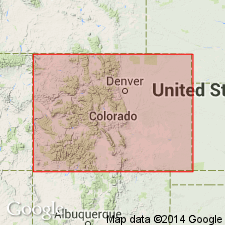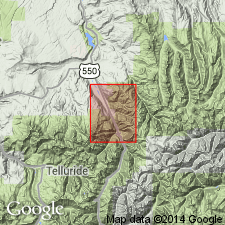
- Usage in publication:
-
- Canyon Creek member*
- Modifications:
-
- Original reference
- Dominant lithology:
-
- Tuff
- Conglomerate
- Agglomerate
- Breccia
- AAPG geologic province:
-
- San Juan Mountains province
Summary:
Pg. 186. Canyon Creek member of San Juan tuff. Lower member of San Juan tuff in vicinity of Canyon Creek, Sneffels, and Ouray, Ouray district, southwestern Colorado. Is most important cliff-forming part of San Juan. Ranges from fine sandy tuffs to coarse agglomerate and breccia, with interbedded conglomeratic beds, which differ from the others by being composed partly or largely of distinctly rounded waterworn boulders of the volcanic rocks. It is mainly by reason of presence of these conglomerate beds and their character that the two fold division of San Juan tuff has been made. Thickness 300 to 1,200 feet. Underlies Sneffels member of San Juan tuff, which is comparatively free from conglomerate layers. The rock fragments composing Canyon Creek member comprise a great variety of lavas, many of them porphyritic andesites and latites. Characteristic color of member is dull greenish gray, but some reddish or purplish beds are present. The coarse agglomerates are commonly chaotic and exhibit bedding only when viewed at a distance, but the tuffs, conglomerates, and conglomeratic beds with which they are interbedded form distinct layers and give a bedded appearance to whole formation. Along Canyon Creek just below Camp Bird mill this member is normally 1,100 to 1,200 feet thick. Unconformably overlies Telluride conglomerate. Age is Tertiary (Oligocene? or Miocene?).
Source: US geologic names lexicon (USGS Bull. 896, p. 339).

- Usage in publication:
-
- Canyon Creek Member*
- Modifications:
-
- Areal extent
- AAPG geologic province:
-
- San Juan Mountains province
Summary:
Canyon Creek Member, lower member of the San Juan Tuff of Miocene? age recognized southwest of the quad boundary along the valley of Canyon Creek, can be extended into this quad with great uncertainty. Quad lies in Ouray Co, CO in the San Juan Mountain province.
Source: GNU records (USGS DDS-6; Denver GNULEX).
For more information, please contact Nancy Stamm, Geologic Names Committee Secretary.
Asterisk (*) indicates published by U.S. Geological Survey authors.
"No current usage" (†) implies that a name has been abandoned or has fallen into disuse. Former usage and, if known, replacement name given in parentheses ( ).
Slash (/) indicates name conflicts with nomenclatural guidelines (CSN, 1933; ACSN, 1961, 1970; NACSN, 1983, 2005, 2021). May be explained within brackets ([ ]).

